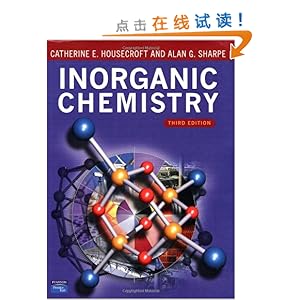Inorganic Chemistry (3rd Edition)
 点此进入淘宝搜索页搜索
点此进入淘宝搜索页搜索分类: 图书,进口原版,Professional & Technical(专业与技术类),
品牌: Catherine HousecroftAlan G. Sharpe
基本信息出版社:Prentice Hall; 3 (2009年10月30日)外文书名:无机化学(第3版)平装:1136页正文语种:英语ISBN:0131755536条形码:9780131755536商品尺寸:27.2 x 21 x 5 cm商品重量:27 gASIN:0131755536商品描述内容简介在线阅读本书
A market leading textbook offering a fresh and engaging approach to the teaching of modern inorganic chemistry while giving a clear, well-balanced introduction to the key principles of the subject. The full-colour text design with three dimensional illustrations brings the subject to life. Throughout the book students are able to reinforce their learning with the use of worked examples and self-study exercises. Numerous applications and topic boxes also relate the chemistry to everyday life.专业书评From the Back Cover
Housecroft & Sharpe'sInorganic Chemistryis established as the leading textbook in the field and has been fully updated in this third edition. Designed as a student text,Inorganic Chemistryfocuses on teaching the underlying principles of inorganic chemistry in a modern and relevant way.
Within a single text,Inorganic Chemistryprovides a balanced introduction to core physical-inorganic principles and to the descriptive chemistry of the elements. Using worked examples and self-study exercises,Inorganic Chemistryreinforces the links between these two key themes. Special selected topics chapters are also included, covering inorganic kinetics and mechanism, catalysis, solid state chemistry and bioinorganic chemistry. New to this edition is a section on carbon nanotubes included in the chapter dealing with solid state chemistry.
Inorganic Chemistry has been carefully designed with teaching aids throughout to enhance learning. A stunning full-colour text design and three-dimensional illustrations bring inorganic chemistry to life. Topic boxes have been used extensively to relate the chemistry to issues in everyday life, the chemical industry, the environment and legislation, and natural resources. New to this edition are also experimental techniques boxes introducing physical methods such as diffraction methods, computational chemistry, ESR spectroscopy and HPLC.
Numerous worked examples take students through each calculation or exercise step by step. They are followed by related self-study exercises, complete with answers, to help build further confidence. New self-study exercises have been added throughout the book. End-of-chapter problems (including 'overview' problems) reinforce learning and develop subject knowledge and skills. Definitions boxes and end-of-chapter checklists provide excellent revision aids while further reading suggestions, from topical articles to recent literature papers, encourage students to explore topics in more depth.
New to this edition
The coverage of 'basic concepts' has been split into two chapters (Chapters 1 and 2).Updated coverage of recent advances in basic inorganic chemistry.Improved coverage of the use group theory in infrared spectroscopy (Chapter 4), of charge transfer bands and UV-VIS spectroscopy (Chapter 21), of term symbols and microstates (Chapter 21), and of magnetism (Chapter 21).New sections on superacids (Chapter 9) and carbon nanotubes (Chapter 28).Many new self-study exercises have been added to the descriptive chemistry chapters. Newexperimental techniques boxes.Updatedapplicationsandresources, environmental and biologicalboxes. In selected boxes, photographs have been included for the first time.Supporting the third edition
Companion Website available at www.pearsoned.co.uk/housecroft Featuring multiple choice questions (including additional questions for this edition)and rotatable 3-D molecular structures.PowerPoint figures and tables for lecturers.A shortGuide for Lecturerswritten by Catherine E. Housecroft.ASolutions Manual, written by Catherine E. Housecroft, with detailed solutions to all end-of-chapter problems within the text is available for separate purchase, ISBN 978-0-13-204849-1.
Catherine E. Housecroftis Professor of Chemistry at the University of Basel, Switzerland. She is the author of a number of textbooks and has extensive teaching experience in the UK, Switzerland, South Africa and the USA. Alan G. Sharpe is a Fellow of Jesus College, University of Cambridge, UK and has had many years of experience teaching inorganic chemistry to undergraduates.








